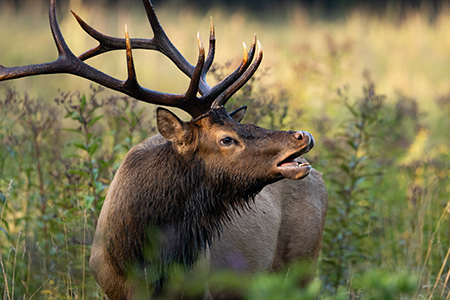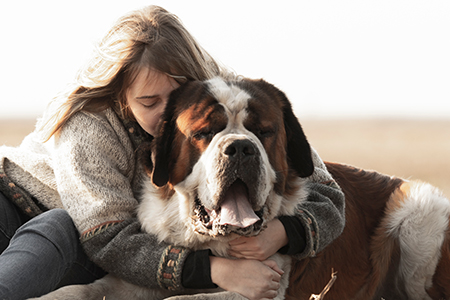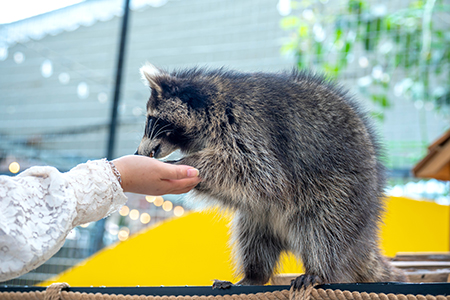
Inside This Issue:
- Catching Poachers with Hairy Robots
- Animals and Horror Movies Are a Powerful Mix
- The Inevitable Next Step in Pet Store Bans
- News Bites: Podcast Reminder, Rescue Rescues, Rabid Raccoons, and More!
Catching Poachers with Hairy Robots

Will I dream, Dave?
A Wisconsin taxidermist, Brian Wolslegel, is using his vocational skills to help wildlife officers nab poachers. Wolslegel fashions highly realistic robotic animals like deer, elk, and moose out of spliced-together remote-control car technology and taxidermy. These decoys can move, emit heat, and even simulate animal droppings, making them highly effective for sting operations.Wildlife officers set up the animatronic animals along roadsides during hunting season, targeting people already suspected of poaching. The lifelike decoys allow officers to monitor suspects from a distance and catch them in the act, rather than relying on chance encounters.
Of course, criminals can adapt to change faster than an urban fox, so Wolslegel regularly updates his designs as poachers catch wind of the decoys. Newer models are more advanced on the inside, too, utilizing heated bodies to fool poachers who use thermal scopes. Other creative innovations, such as CO2 systems to simulate breath on cold days, make the decoys that much more convincing. Wolslegel’s creations are so believable they have even been used in movies and commercials. These decoys can withstand the elements and are budget friendly for law enforcement, deterring poaching and generating substantial revenue from fines – talk about a return on your investment!
Source: Wisconsin man brings taxidermied animals to life to fool poachers
Animals and Horror Movies Are a Powerful Mix

Now go and hug your Saint Bernard.
There’s something primal about the way animal-centered horror movies disturb us and feel so unnatural. Whether animals are the victims or the threat, their presence invokes our deep connection to them, bringing up deep-seated emotions. It’s hard not to conjure up our protective instincts when an animal – especially a beloved pet – is in danger on screen because our gut reaction is to root for them. In these movies, a lot of us worry about the safety of the animals more than we do the human characters. And what about when a scene goes from the threat of violence to actual violence? We all know that person (or are that person) who can calmly handle a blood-spattered camera lens panning through a room of brutally dispatched human corpses, but if they see someone kick a cat, they’re immediately up and out of their seat, yelling at the screen.
This is a natural response. Part of what makes these films so effective is how animals blur the line between innocence and danger. Most of us have experienced those unsettling moments when a dog barks at nothing or a cat seems to spot something invisible. Animals feel like pure-hearted companions, but in the right scenario, they can also become unpredictable or even deadly.
Recent films like Good Boy play on this tension by telling their stories through the eyes of a loyal dog who senses supernatural threats that his owner can’t see. The result is a movie that makes viewers deeply invested in the animal’s fate, amplifying the suspense and emotional intensity. This dynamic isn’t new. The classic Stephen King adaptation of Cujo (1983) features a rabid dog terrorizing a mother and son. A huge part of what makes this story so memorable is the dissonance between the loving and loyal dog Cujo used to be compared to the murderous hellhound he became after rabies started eating his brain. You can't help but feel terrible for the doomed dog, too. As the viewer, you’re getting hit with terror and tragedy at the same time, and it packs a wallop. Stories like these hit us hard because animals aren’t just sidekicks, they’re our best friends and family members. Whether we’re afraid for them or afraid of them, their role in horror movies forces us to confront our deepest fears and affections all at once.
Source: Why Horror Movies About Animals Always Hit a Nerve
The Inevitable Next Step in Pet Store Bans
On occasion, we have been accused of employing the “slippery slope fallacy” in our arguments against bad animal policies. This is kind of amusing to us, because for our slope to be fallacious, there would 1) have to be insufficient evidence linking the chain of events we describe, and 2) a lot of the people who support the bad policies we oppose are, quite frankly, completely open and transparent when it comes to their intentions and end goals. Can you really call something an unintended consequence when someone has been shouting "This was only the first step!" into your ears for the last 45 minutes? So while we would love to take credit for cracking the code of bad animal policies, it really doesn’t take a rocket scientist to predict their outcomes and end goals.
Take West Hollywood’s recent ban on the retail sale of pretty much all live animals. Anyone with a sense of history could have seen this coming from a mile away – it practically follows the activist playbook to the letter.
First, you pick a soft target like West Hollywood. Next, ban the retail sale of non-rescue “traditional” pets (i.e. dogs and cats). Once that’s done, sit back and wait awhile, and once that’s been normalized in people’s minds, move on to all the other animals. Boom – now only rescues can be in the pet business. Bonus section: as folks who follow these chains of events may have already predicted, this current ban will affect “only” one pet store, which guaranteed minimal pushback, while the people campaigning for the ban still get to take credit for effecting major change in an entire city or region. It’s a tried and tested recipe for success, and it’s pushed by people who, again, are completely open about where they are coming from. Whether it’s the spcaLA president’s hopes that this ban will inspire other jurisdictions or the Animal Alliance Network’s comment about how there is never a need to breed and sell animals so long as they can supply the area with shelter pets*, the slip of their slopes couldn’t be more clear.
Source: West Hollywood elects to ban retail sales of nearly all live animals
* We feel safe in predicting that somehow, no matter how many breeding bans are passed in the area, they will always always have more than enough animals on hand.
News Bites: Podcast Reminder, Rescue Rescues, Rabid Raccoons, and More!

Stop doing this.
Make sure to check out NAIA's latest Speaking of Animals podcast featuring Dr. Arnold Goldman and Patti Strand, where Dr. Goldman discusses the benefits of independently owned veterinary practices and the Independent Veterinary Practitioners Association!
In yet another case of “rescues rescuing from rescues,” authorities seized seven dogs and 37 cats from New Jersey’s Lost Paws Animal Rescue earlier this week. This follows a lengthy investigation into Lost Paws, which had been under scrutiny for bringing sick and filthy animals to adoption events. The state of the animals recovered from the rescue was generally awful: many of them had respiratory infections, parasites, and injuries – and at least one was pregnant.
The fact that Lost Paws felt its animals were in acceptable shape to bring to adoption events – as opposed to, say, a veterinarian – raises questions about their judgement and perhaps even their mental state. In cases like this, it is important to remember that some folks get so caught up in their zeal for “saving” every animal, they end up hurting more than helping. Whether that is what happened here is a matter of speculation, but it is always worth considering before assuming villainous intent on the part of the rescue.
Whether or not someone has good intentions doesn’t prevent respiratory infections, though. What would really help here is for rescues to be licensed, inspected, and shut down when necessary – just like any other entity that works with and cares for animals.
In a press release, our friends at USARK Florida condemned the neglect and abandonment of over 100 African fat-tailed geckos discovered in a Florida storage unit, emphasizing that the perpetrator’s actions do not reflect those of responsible animal keepers. The organization collaborated with authorities at FWC to ensure the surviving geckos received proper care and supported legal action against the individual responsible. USARK Florida reaffirmed its commitment to animal welfare, responsible reptile ownership, and ongoing public education to prevent similar cases of cruelty.
We’ve already talked about the screwworm more than we’d like this year, and now the FDA is doing something it probably hoped to avoid, as well: an emergency use authorization allowing the use of animal drugs not approved in the U.S. to help prevent and contain screwworm outbreaks. Focusing on the agricultural economic loss caused by screwworm pulls up some jaw-dropping numbers, but those numbers pale to the visceral response you feel when seeing the damage a screwworm infestation can cause to an infected animal. It’s pretty nasty stuff – and hopefully something we can stay ahead of.
Speaking of nasty infections, if you are hanging out in South Carolina, please resist the urge to pet any raccoons you come across. It’s tempting, we know, but several animals in the state have recently tested positive for rabies, and prophylaxis ain’t fun (though reportedly a lot less painful than it used to be). Also, please use this news as inspiration to keep your pets’ rabies vaccines up to date!
Someone asked about the woman with the history of making animal torture videos who was arrested after being caught with 12 starving dogs and cats in a van last June: she received 18 months in federal prison. Bruno, the lost dog she and her accomplices took, claiming he was theirs, has not been recovered. It's good she's going back to prison, but still a very sad and unsatisfying conclusion to the story.
Out of Spain, an El País article makes some interesting observations while raising big questions about first-time motherhood and the “maternal instinct” – or its absence. Whether it’s the higher mortality rate for first-born primates compared to their siblings, an older elephant experiencing a calmer, more successful birth compared to younger members of the herd, having that first baby is a rough time for a lot of species. So how much of this can be chalked up to an individual’s personal experience and their cultural influence? How much is simply biology and instinct? And now that we’re talking, what is instinct – when you or I say “it’s instinctual,” it may not mean the same thing to a neuroscientist or sociologist!
Also in the News...
★ (Video) London Zoo's capybaras and tortoises on weigh-in day (Are These Animals Getting Too Fat and Capy?)
★ WA's Tacoma Humane helping more than 50 animals seized from South Prairie property (Serious Neglect & Injuries; Wide Range of Animals)
★ Local Walmarts to Enforce New Rules for Emotional Support Animals Starting September 1 (The End of Emotional Support Snakes)
★ The Surprising Hudson Valley Animals That Actually Climb Trees (Pocupine Cannonball?)
★ Twentynine Palms woman arrested for cruelty to animals after allegedly throwing and killing puppy (Sibling Dispute Allegedly Leads to Puppy Death)
★ Think like a crow, choose like a crab: The animals inside our minds (Choose Your Shell Wisely)
★ The Most Common Animals You’ll Spot When Hiking in Tennessee (Walking Lists; From Chipmunks to Copperheads)
Sign up for the 2025 NAIA Conference Today!
Click here to see what is happening legislatively



